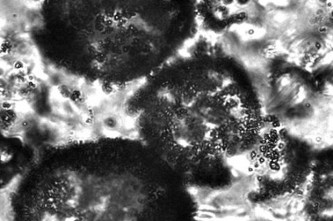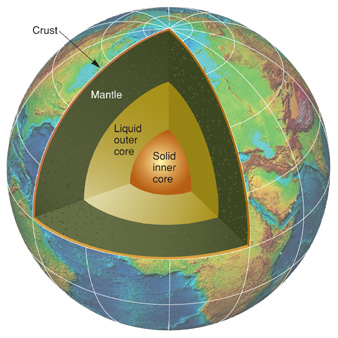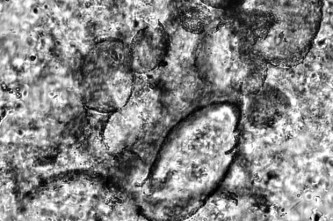
Recently discovered microfossils are believed to be the oldest ever found on Earth. (Photo: Dr David Wacey of the University of Western Australia)
Researchers from England and Australia recently found some microfossils in a remote part of Western Australia.
Before you click away and say, “Big deal another fossil find,” hang with me for a bit.
The microscopic fossils, according to the researchers, are 3.4 billion years old, making them Earth’s oldest fossils.
The fossils resulted from life forms which lived on our planet before Earth even had oxygen.
Wow! Kind of hard to visualize Earth without its life-giving oxygen, isn’t it?
OK, lets step back to the time when Earth first formed.
Most scientists generally agree that our planet is between 4.5 and 4.6 billion years old.
Soon after being formed, Earth was a huge molten hunk of rock with no atmosphere and, of course, none of the characteristics that make our planet special.

Illustration of the inner earth (Image: Lawrence Livermore National Labs)
At this time, Earth’s core was also still forming. There was no solid inner core or liquid outer core, like there is today, so the world wasn’t able to retain gasses very well.
Scientists describe our first atmosphere as being composed of hydrogen and helium, two elements which were very common when Earth and the rest of the solar system were formed.
Because of the heat and unformed core, these gasses soon escaped from Earth into space.
Earth continued its cooling process and, as the core began to stabilize, the earth’s magnetic fields were formed.
A more stable core and a cooler planet meant that more of the gasses produced by our evolving world could be retained closer to its surface.
As volcanic activity began and continued to increase throughout the planet, a lot of different gases formed as a result.
These included carbon dioxide (CO2), carbon monoxide (CO), sulfur dioxide (S2), chlorine (CL2), nitrogen (N2), deuterium, also called heavy hydrogen (H2), ammonia (NH3) and methane (CH4).
The volcanoes also produced a lot of steam (water/H2O), but no free existing oxygen (O2).
Oxygen was later produced and introduced into our atmosphere through two processes; photochemical dissociation, caused by the breakup of water molecules by the sun’s ultraviolet light, and photosynthesis, the process that uses carbon dioxide and water (H2O) to form organic compounds while also releasing oxygen (O2).
Early forms of life that developed and lived during this “pre-oxygen time”, some 3.4 billion years ago, were sulfur-based cells and bacteria which lived off metabolized compounds which had sulfur, rather than oxygen, for energy and growth.

According to researchers, these microscopic fossils are 3.4 billion years old. (Photo: Dr David Wacey of the University of Western Australia)
The researchers, from the University of Western Australia and England’s Oxford University, say their discovery of these microfossils provides convincing evidence that these unique early life forms did exist.
Oxford Professor Martin Brasier, one of the team’s leaders, says the life forms of the fossils still exist and are common today.
The sulfur-based bacteria can be found in smelly ditches, soil, hot springs, hydrothermal vents – anywhere there’s little free oxygen and they can live off organic matter.
Professor Brasier says their discovery also has implications in the search for life on other planets, giving scientists an indication of what evidence for such life might look like.
A report on this finding can be found in the journal Nature Geoscience.





















The most interesting conclusions from studies / finds such as this is that it demonstrates the diversity and creativity of life. We have evidence of all sorts of life forms here on Earth surviving in a myriad of very different environments. I’m especially intrigued by the life found around the hydrothermal vents on the deep sea floor.
I can only imagine whenever life is finally discovered on another world the array of reactions this will have on the still-primitive human race. No doubt one side of the political aisle will discredit the find as Earth-contamination or a hoax or outright lie. No doubt writers will cash in.
I just find it intriguing to think about the ridiculousness that will ensue if one day the human race finds extra-terrestrial life – clever enough to go and find it – but not wise enough to truly learn from it.
Wow! It’s fascinating that we are still learning new things about our very old planet.
What evidence is there to support the idea that these fossils came from earth and are not debris from meteorites?
On the other hand, there is nothing that suggests that they were more likely to come from meteorites than from Earth itself.
While it’s true they are found on some of the oldest land on earth you would still expect them to be found in other locations; perhaps South Africa. As they are so far localized (and not a global phenominon) the assumption is they are debris from one of the many impact craters in the local area. Assuming they are native to our planet is just as erroneous as assuming them to be foreign.
It’s lazy science to skip such an important step and determining place of origin.
Fossils, especially those that are more ancient are very rarely found in more than one spot simply because the longest their age, the bigger are the odds that the rocks that contain them will be subdued, eroded or simply destroyed. That is why you find more recent fossils than older ones, and in some cases, species are known just for bits of just one incomplete specimen found. Take for example, some animals from the Ediacaran period. Because they were found at just one place, in Australia, your hypothesis would be automatically valid, and that is not the case. It is indeed possible that panspermia brought them to Earth by means of a meteorite. However, having two equally acceptable explanations, the scientific method requires you to accept the most probable one, and that is, they originated on Earth. As suggestive as your explanation might seem, we should assume that they were Earthlings as long as life outside our planet has not been demonstrated clearly to exist.
Super find.
sulfur based cell life form…found in smelly ditches…hehe…anybody got a joke?
This is impossible, because the Bible is very clear: the earth is only 6,000 years old! When will the left-leaning liberal media (VOA) stop running Tea Party Patriots into the ground and brainwashing our children? America is being ruined by taxdollars being wasted on liberal “evolution” brainwashing. Read the Bible, folks! It is very clear on this matter. The earth is only 6,000 years old! duh!!
Genesis 1 vs 1 says in d beginning God created d heavens an d earth. Vs 2 says that the earth was without form or void and darkness was upon d face of d deep. The world God created in vs 1 was a perfect heavens n earth. Sth happened to it that made it to be without form and void. Biblical counting started from verse 2, or after .an entered d scene cos nobody knows d no of years btw vs and vs 2 of Genesis 1. Billions of years could have separated vs1 of genesis from its vs2.
That’s true.the bible says it all